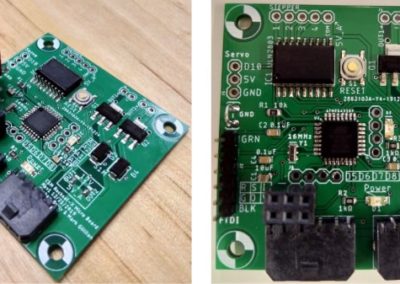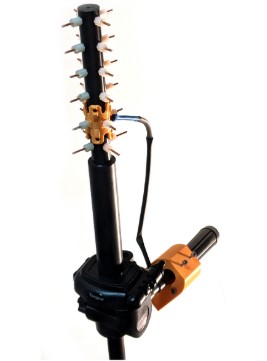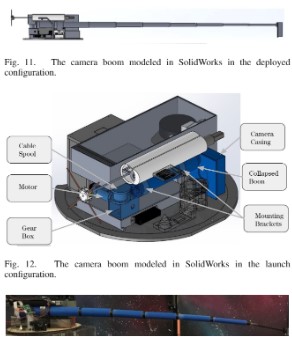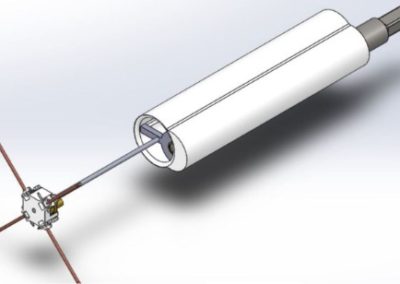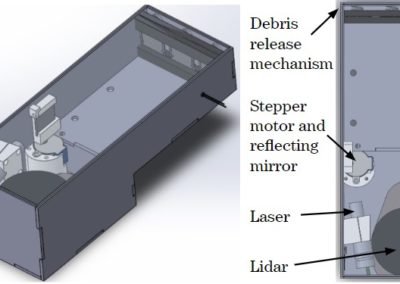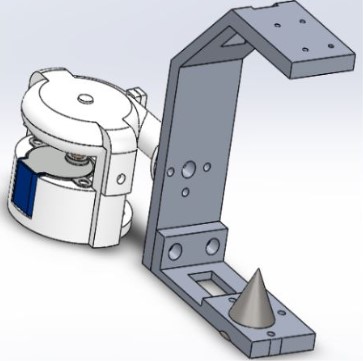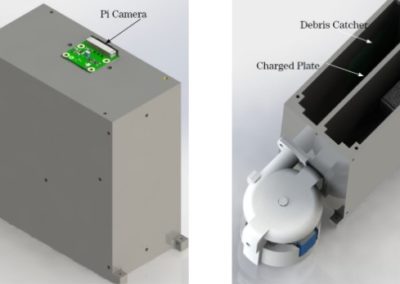RockSat X
Overview
What is RockSat-X?
RockSat-X is a competitive program put on by Colorado Space Grant Consortium and NASA Wallops Flight Facility where schools are given an opportunity to perform experiments in space, with flight hardware that is designed and constructed by students. Experiments in the past have ranged from collecting tiny meteorites to flying robots to taking debris out of Earth’s orbit. These experiments have a few limitations, however. They need to fit on a plate that’s 12” across – about the size of a big cast iron skillet – and be no taller than 5” or 10”, depending on the payload size the team purchases. The experiments must also be fully autonomous, meaning that they can’t be controlled from the ground, so all the programming must be done beforehand. There is a limited amount of time, about 3 minutes, that teams can perform experiments. The rocket provides a limited supply of power to all the experiments on board. Past this point, teams have the liberty to test whatever they can imagine as long as they meet the restrictions. Given that there are limited slots on the rocket, teams’ experiments must pass a series of evaluations before being selected to fly on the rocket.
What is Operation DUSTER?
Operation Debris Under Size 1cm Trajectory Edit for Removal (DUSTER) is the Colorado School of Mines RockSat-X team, which is also a Capstone team. Our goal is to remove small pieces of debris from Earth’s orbit. When you think of debris from a satellite breaking up, or perhaps the Challenger space shuttle disaster, you probably think of most of the debris being large chunks that could cause problems. Although these large pieces can cause space flight issues, they are a bit more obvious and easier to avoid. The more dangerous debris is the stuff you would probably never think of – things that are the size of BBs (from a BB gun), up to the size of a marble. Debris that size seems harmless, but have you ever been shot with an airsoft or paintball gun? Pelted with a marble by your sibling or child? They can leave some pretty good welts. The particles of space debris are traveling at around 18,000 mph. This is about 80 times faster than a BB gun and fast enough to do some incredible damage to spacecraft trying to enter Earth’s orbit or go beyond. This is why Operation DUSTER is testing 3 different ways to alter the momentum of these small pieces of debris so that they leave orbit and burn up while falling through Earth’s atmosphere and are no longer a harm to potential space travel.
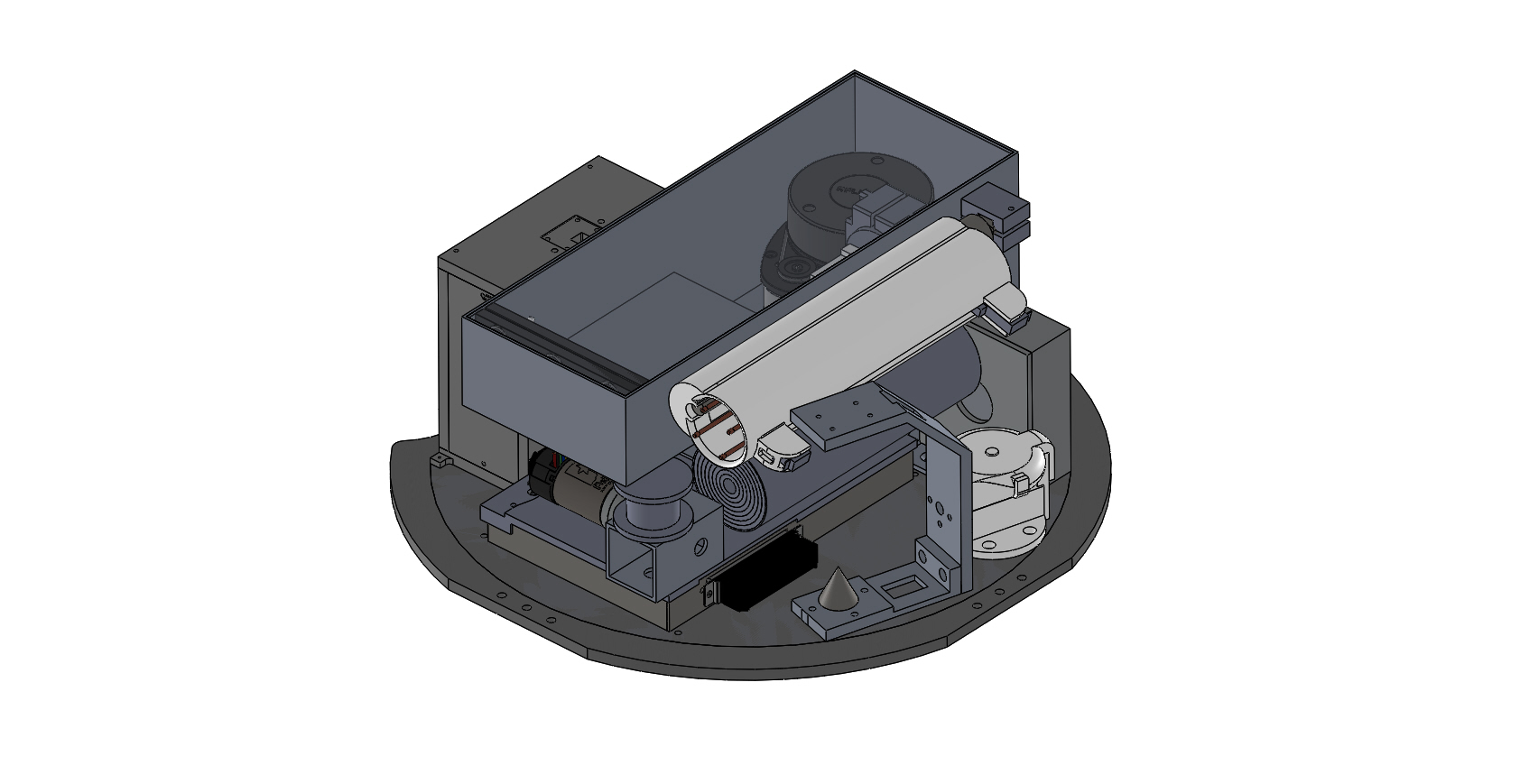
Team Members
- Bri Treffner
- Bradley Jesteadt
- Nik Geschwentner
- Kaylee Cuyler
- Mark Gilliland
- Graham Braly
- Brandon Hinkle
The Client
- Colorado Space Grant Consortium
Acknowledgements
The team would like to acknowledge the following people: James Beseda (Capstone Project Advisor), Professor Angel Abbud-Madrid (Space Grant Project Advisor), Dr. Jeff Squier, Dr. William Finch, and Professor Payem Nayeri, for their continued support on the development of this extensive design project. The team would also like to acknowledge the following students: Meadow Bradsby, Chuck Fuller, Adam Hugo, Jason MacKay, Alec Samarchuk, Evan Spruce, Taryn Tucker, and Logan Walden for their help and support on the development and realization of this project.
Additionally the capstone team would like to thank the rest of the Mines Rocksat-X team: Annie Strange, Galen Stevenson, Nikki Bernuy, Parker Damon, Forrest Doherty, Melanie Dotson, Randall Henry, Ethan Howard, and Claire Thomas. You all are brilliant and creative engineers! 🙂
Video
Elevator Pitch
Mines’ RockSat-X team is building a small rocket payload deck that will perform experiments impacting research on removal of space debris. Space debris is an important problem to solve: the Kessler Syndrome shows that space collisions launch thousands of bits of debris at thousands of miles an hour, each of which can then collide with other objects, creating a cascading effect of increasing damage and debris.
Concievably, this could lead to a scenario where space travel is dramatically hindered by the high likelihood of damages from debris. While much research is being put into this, it is largely focused on large debris, like intact-but-crippled satellites. Our experiments focus on small debris that cannot be tracked but which can still do notable damage.
Come august this will be the first time Mines students have built something to be put into space, which is an incredibly exciting experience for all of us. We’re extremely grateful to be a part of such a momentous project and to work with such awesome people as the mentors and club members who are supporting this project.
Design Approach
The Colorado School of Mines Rocksat-X team was established during the of Fall 2018 with the intention of being a multi-year, multi-team program, to design, develop, and implement innovative methods to change the trajectory of small scale space debris. This debris is small enough that it cannot be tracked using ground based systems and is one of the largest risks to current space missions. As such, the team intends to continuously build upon previous successes and failures in research and development, iterating design consistently as the project develops to solve this mission critical issue.
The first challenge of the team was determining how best to remove such small and untrackable debris from orbit. Concepts included: (1) collecting and housing the debris on a payload that could return the debris into Earth’s atmosphere, (2) launching the debris out of orbit and sending it to another orbiting system (such as the asteroid belt), and (3) redirecting the debris by changing the momentum so that it would fall into Earth’s orbit, burning up in the atmosphere and eventually destroying itself.
Due to the high speeds of the debris (~18,000 mph), as well as the difficulty involved in a process which requires a container to transport debris back to earth, and the constraints of the payload size and weight, method (1) for removing space debris was abandoned as impractical and not realizable at this scale. Method (2) was likewise determined as impractical, due to the difficulty in finding ways to slingshot a particle out of Earth’s orbit if it’s impossible to track its trajectory and the risk of unintended consequences.
On account of these limitations with the first two methods, the team decided to focus on the design of systems which would be capable of changing the momentum of untrackable space debris, allowing them to fall into Earth’s atmosphere.
At the project genesis, five design concepts were initially considered as candidates for removing these untrackable space debris. These designs were analyzed based on several factors, including cost, feasibility to manufacture, and the ability to detect and deorbit the untrackable debris. These experiments included five methods for potentially altering particulate momentum: magnetic forces using a permanent magnet design, static electrical forces using capacitor plates, light momentum using the power of lasers, gas pressure with a compressed gas canister design, and contact interference using ballistics gel.
Today, the first three of these experiment designs have survived analysis and bench-testing, and their successes and failures are discussed more in the Design Solution. The compressed gas and ballistics gel experiments were quickly abandoned however, due mostly to the hazards associated with their potentially explosive nature (and general concerns with putting an explosion-capable experiment into a flying object).
The overall mission further includes the development of a communication system. This communication system was designed with the intention of sending pictures from an onboard camera to a ground station, taking pictures of the payload with Earth proudly in the background. Difficulties in the physical realization of this system also led to design iterations.
The camera needed a design concept which would allow it to leave the physical barrier of the payload, so that it could take photos of the payload and Earth. The initial design of the boom included a tape measure design, which would fold around the perimeter of the payload and snake out into an extended ~6 ft boom. Since then, the design has been edited to make the boom more robust and the camera more secure, and the tape measure design has been altered into a telescoping design (similar to an old phone or car radio antenna), due to limitations with manufacturing the prototype tape measure boom.
The transmission system, which will send photos from the payload, once at apogee, to the ground system, also saw several iterations over the course of the project due to the fact it was the team’s first experience working with complex communication systems. The team initially considered using laser communication, sending the data of interest from the payload to ground using laser pulses. This idea was eventually abandoned, due to potential difficulty in obtaining approval to use high power laser pulses to communicate with an Earth station (in addition to the difficulty in designing such a system). Instead, the idea was replaced with an RF design, where a low power antenna design needed to be developed for the transmission side of the communication system. Eventually the team focused on designing a deploying dipole antenna design for the transmitter (which will deploy like an umbrella from the payload) to send images over radio frequency back to Earth from the onboard camera. This antenna design was chosen due to its flexibility with directionality and its low power consumption.
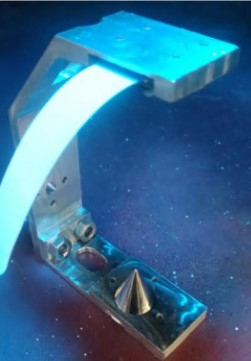
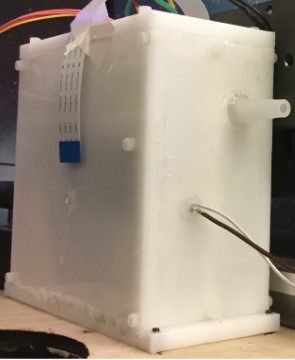
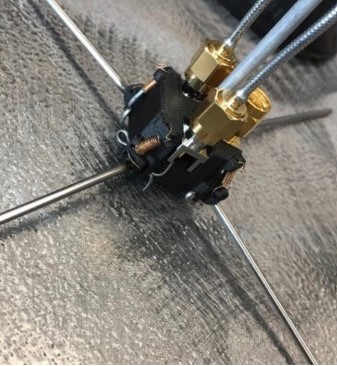
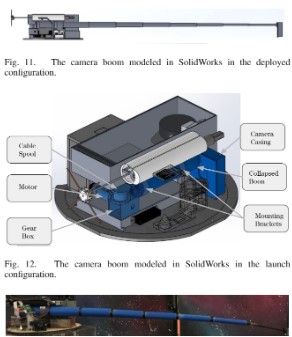
Design Solution
Part of the design challenge presented is designing mechanical and electrical hardware that the team needs to be able to manufacture and assemble using on-campus resources. The subsystems were prototyped and then manufactured with materials suitable for spaceflight.
The magnet subsystem went through numerous design iterations early on, to determine the best geometry to align the camera, magnet and anticipated flight path of the simulated debris. The settled-upon design is extremely open and simple to manufacture, and thus few changes have been made since, and it was fully manufactured early on. Some simple changes (such as adding kapton tape to electrically isolate the camera) were made as needed.
The laser subsystem, from the beginning, struggled to be space efficient enough to fit on the payload. Initial designs involved pivoting a laser to shine on various pieces of simulated debris. This was found to require unaffordable amounts of space and a strong motor, since the laser itself was relatively large. To manage this, the laser was made fixed, and a rotating mirror was used as the method of directing the beam instead. The chosen laser, when tested, proved to be extremely underpowered compared to its spec sheet. Redesign was needed to allow for the retrofitting of the system with a larger, more powerful laser. Concerns were also raised, in addition to the compactness of the experiment, as to whether the LIDAR could reliably measure the position of the debris; these fears have been largely alleviated through bench testing of the sensing equipment.
The static subsystem posed many challenges, but the largest by far was how to electrically isolate the experiment while allowing for the pressure to change to match that at apogee. This experiment utilizes an ion generator that generates a very high voltage in order to charge an aluminum plate. This plate will then be used to alter the trajectory of the debris as it travels past it. The risk of high voltage escaping the experiment and compromising the payload and its experiments was mitigated through material selection, gap sealant, and careful testing. The material for this enclosure was high-density polyethylene (HDPE), which has excellent electrical insulation properties, and the enclosure itself is completely sealed at all seams to ensure isolation. A pressure release valve was integrated into this design to allow for depressurization inside the box once at apogee. The valve will allow air pressure to escape before closing once at equilibrium with the outside pressure, which at apogee will be vacuum. Upon closing, the ion generator will be powered and the experiment will begin. Inside the static box, there is a wall that separates the experiment space from the ion generator. This is to add an extra layer of protection from the high voltage generator. The box is oriented so that the generator is on the outer edge of the workspace to further remove it from other systems.
Significant advancements were made regarding the payload’s electronics and programming. Control and data networks were created using a mixture of Arduino-compatibles and Raspberry Pi’s. Arduinos handle real-time tasks like actuator activation and sensor readings, while Raspberry Pis command the arduinos, handle more complex tasks, and record data. Custom circuit boards were designed in order to ensure a reliable system which met our team’s needs. These circuit boards were iterated on to arrive at solutions which are reliable and meet the requirements our payload demands. Programming consisted of Arduino, Python, and Bash scripting working in parallel to achieve different tasks, like photo capture, inter-system communication, and datalogging.
Next Steps
The design team will continue working on Operation DUSTER after the school year is concluded. The payload components have been manufactured, but full system integration is ongoing, and getting the payload to a flight-ready state will take more work by the team. Additionally, full mission simulations of the integrated system need to be conducted – which is basically turning the payload on and watching it perform the tasks as designed, and fixing the inevitable issues that arise.
In June 2020, The payload will undergo rigorous testing by COSGC at Wallops Flight Facility in Virginia in order to evaluate if the payload is ready for launch. In August 2020, the payload will fly on a sounding rocket, performing the experiments and fulfilling the Operation DUSTER mission. Analysis of the data collected from the flight of the payload will be conducted, allowing for future experiments and implementation of non-contact debris removal methods to have a more solid scientific background.
To ensure the success of the mission, it is important for many of the team members to continue working on the project, even after graduation. Thankfully, the efforts to manufacture hardware early in the year allows for the mission to be completed on the planned timeline, even in light of the impact from COVID-19 shutdowns.
There is significant interest in a subsequent Mines RockSat team to work on a new payload next year. The engineering techniques, lessons learned, and hardware developed for Operation DUSTER will be passed on to the future teams in the form of thorough documentation, physical hardware, and contact information for some of the team members who were a part of Operation DUSTER.
Meet the Team
Brianne Treffner
 Senior in Engineering Physics, she previously participated on a Rocksat-X team at Red Rocks Community College focusing on resolving the issue of orbital debris and culminated in a launch in August 2018. Using this background as a launch pad to start a Mines team, she has focused on the design and manufacture of the static electricity experiment. She spends her free time backcountry snowboarding, hiking, and painting.
Senior in Engineering Physics, she previously participated on a Rocksat-X team at Red Rocks Community College focusing on resolving the issue of orbital debris and culminated in a launch in August 2018. Using this background as a launch pad to start a Mines team, she has focused on the design and manufacture of the static electricity experiment. She spends her free time backcountry snowboarding, hiking, and painting.
Bradley Jesteadt
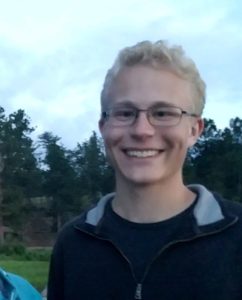 Senior in Mechanical Engineering, designed magnet E&M experiment and significant portion of laser experiment on payload, led CNC and mill manufacturing. Brad’s a Maker, artist, skier, robot enthusiast, electronics hobbyist, and vinyl collector.
Senior in Mechanical Engineering, designed magnet E&M experiment and significant portion of laser experiment on payload, led CNC and mill manufacturing. Brad’s a Maker, artist, skier, robot enthusiast, electronics hobbyist, and vinyl collector.
Nik Geschwentner
 Senior in Engineering Physics, led the design of the RF wireless communication system. He spends his free time skiing, golfing, fly-fishing and looking for more free time.
Senior in Engineering Physics, led the design of the RF wireless communication system. He spends his free time skiing, golfing, fly-fishing and looking for more free time.
Kaylee Cuyler
 Senior in Mechanical Engineering, designed the debris launchers, static experiment, payload communications antenna, and protective electronics cases. Integrated subsystems on to payload and managed the workspace. Kaylee is a photographer, painter, skier, and avid dog-mom.
Senior in Mechanical Engineering, designed the debris launchers, static experiment, payload communications antenna, and protective electronics cases. Integrated subsystems on to payload and managed the workspace. Kaylee is a photographer, painter, skier, and avid dog-mom.
Mark Gilliland
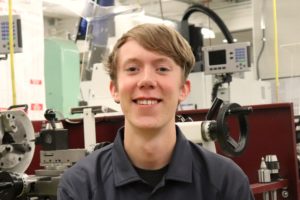 Senior in Electrical Engineering, co-designed printed circuit boards. Programmer for data control board, providing knowledge of PCB design and assembly techniques. Mark loves to cook, 3D print useless things, go to concerts, and play videogames.
Senior in Electrical Engineering, co-designed printed circuit boards. Programmer for data control board, providing knowledge of PCB design and assembly techniques. Mark loves to cook, 3D print useless things, go to concerts, and play videogames.
Graham Braly
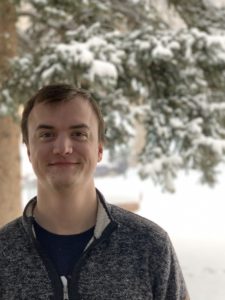 Senior in Electrical Engineering, co-designed printed circuit boards. Programmer for experiment control boards. Provided electronics experience for science experiments and engineering experiments. Graham is an electronics hobbyist, programmer, tech enthusiast, and music lover.
Senior in Electrical Engineering, co-designed printed circuit boards. Programmer for experiment control boards. Provided electronics experience for science experiments and engineering experiments. Graham is an electronics hobbyist, programmer, tech enthusiast, and music lover.
Brandon Hinkle
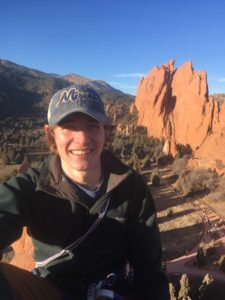 Senior in Mechanical Engineering, has helped the project by providing knowledge about materials, as well as manufacturing different components of the payload. He also likes to run, hike, and go rock climbing in his free time.
Senior in Mechanical Engineering, has helped the project by providing knowledge about materials, as well as manufacturing different components of the payload. He also likes to run, hike, and go rock climbing in his free time.
